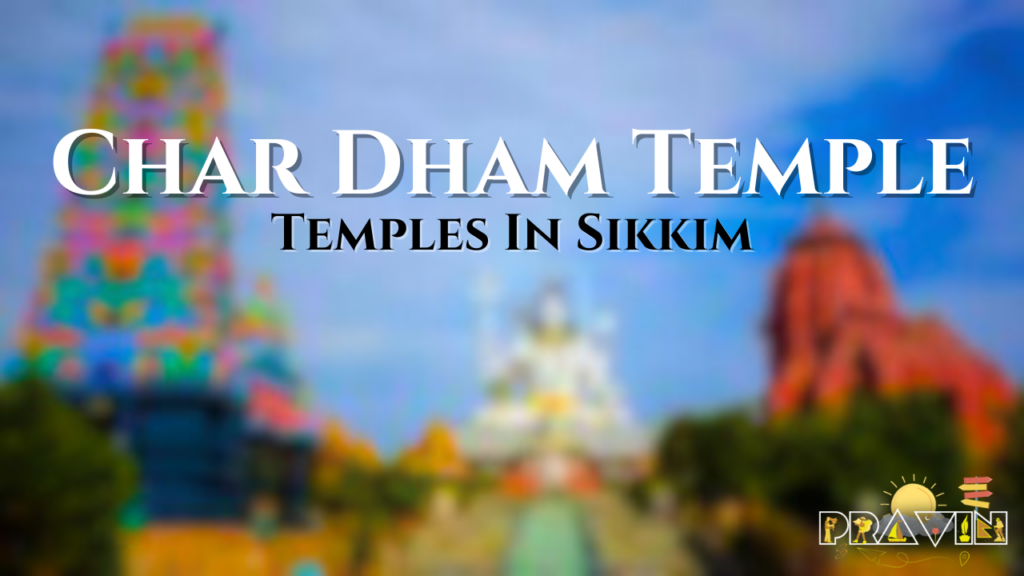Chardham Temple in Sikkim is one of the many hidden gems the state has. This magnificent temple complex, also known as Siddheshwar Dham, is a replica of the famous Char Dham pilgrimage sites in India. On my previous visit to Namchi, I had to visit this remarkable temple that the locals of Sikkim had told me about.
In this blog, I share my experience of the time I visited the Chardham Temple in Sikkim and all the stories that I have heard about the place.
Chardham in Temple
If you ever find yourself in Sikkim, the Chardham Temple in Namchi is a place you absolutely have to visit. Officially called Siddhesvara Dham, it’s perched on Solophok Hill and is unlike any other temple complex I’ve seen.
What makes this place special is that it replicates the famous Chardham temples from different parts of India—Badrinath, Dwarka, Puri, and Rameswaram—all in one spot. When I first saw it, I was amazed by how closely these replicas resemble the original temples. And the towering 87-foot statue of Lord Shiva in a meditative pose? It’s hard not to feel a sense of calm just standing there.
But it’s not just about the Chardham replicas. The complex also has temples dedicated to Sai Baba and Kirateshwar Mahadev, along with replicas of the 12 Jyotirlingas. It’s like a mini spiritual tour of India, all in one place. What really took my breath away, though, were the views. Being on a hilltop, the temple offers stunning panoramic views of the surrounding mountains and valleys. It’s the kind of place where you can just sit and soak in the peaceful vibe for hours.
The temple was built to promote religious tourism, but even if you’re not on a pilgrimage, it’s worth a visit for the architecture and the serene environment alone. Plus, it’s easy to get to by road, making it a popular stop for tourists and devotees alike.
Location Of Char Dham Temple in Sikkim
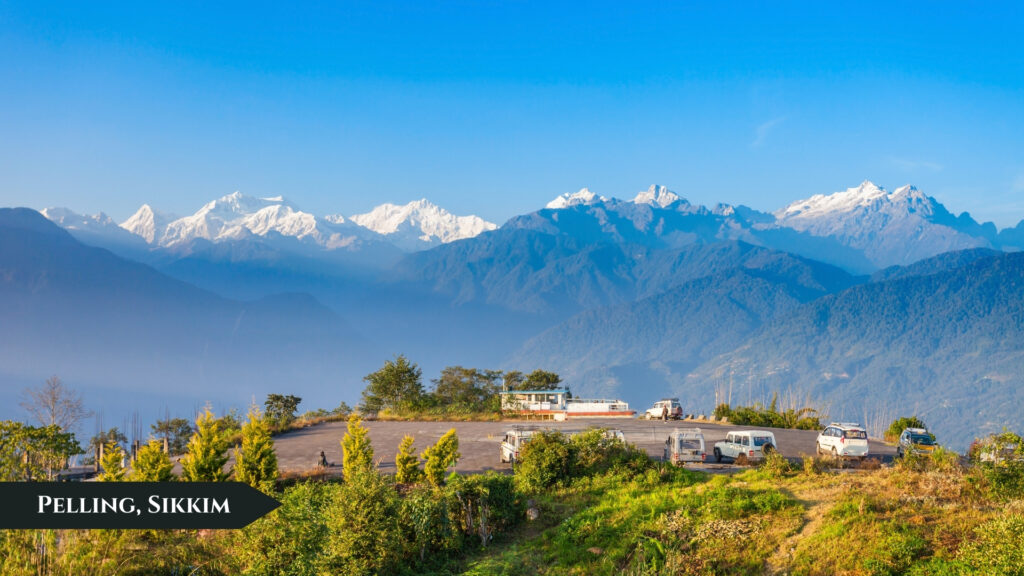
The Chardham Temple is located in Namchi, the capital of the South Sikkim district. Situated on the Solophok Hill, the temple complex offers panoramic views of the surrounding mountains and valleys. Namchi is known for its scenic beauty and spiritual ambiance, making Chardham Temple a significant attraction.
How To Reach Chardham Temple
If you are planning on going to Chardham Temple, you have to reach Namchi first. Namchi is well-connected by road and can be reached from various parts of Sikkim and West Bengal. The nearest airport is Bagdogra, and from there, you can take a taxi or a shared cab to Namchi. Once in Namchi, you can hire a local taxi to reach the Chardham Temple, which is about 5 kilometers from the town center.
What Is The Main Attraction Of Chardham Temple
The main attraction of Char Dham Temple is its stunning architecture and the fact that it houses replicas of the four sacred Char Dham temples of India – Badrinath, Dwarka, Jagannath, and Rameshwaram. The complex also features a towering statue of Lord Shiva, which is a major highlight. The serene environment and the spiritual aura make Char Dham Temple a must-visit for anyone seeking a blend of devotion and tranquility.
Chardham Temple Architecture
Here’s an overview of the architecture and features of Char Dham Temple:
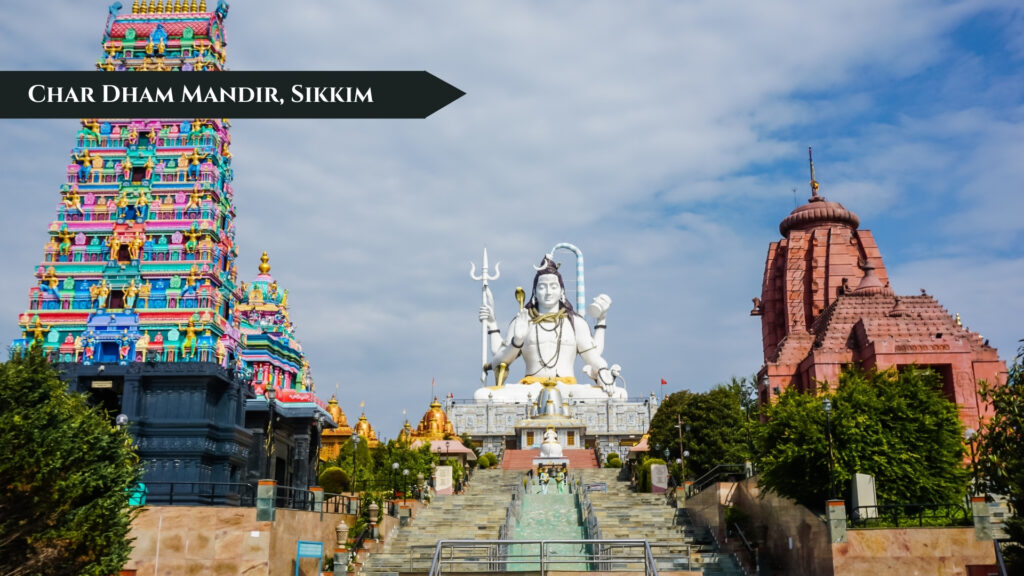
Architectural Style
- Replicas of Char Dham Temples: The architecture of Char Dham Temple replicates the design of the original Char Dham temples, showcasing a blend of traditional Indian styles.
- Grand and Majestic: The temple complex is grand and majestic, with intricate details and beautiful designs that capture the essence of the original temples.
Structural Elements
- Main Shrines: The main shrines house the idols of Lord Vishnu, Lord Shiva, Lord Jagannath, and other deities. Each shrine is a replica of one of the Char Dham temples.
- Shiva Statue: The complex features a 87-feet tall statue of Lord Shiva in a sitting posture, which is a major attraction. The statue is beautifully crafted and adds to the spiritual ambiance of the place.
- Prayer Halls: The temple has spacious prayer halls where devotees gather for rituals and ceremonies. These areas are open and airy, facilitating the flow of air and light.
- Entrance and Courtyard: The temple features a grand entrance leading into a well-maintained courtyard. The courtyard is often used for community gatherings and religious events.
Decorative Elements
- Intricate Carvings: The temple walls and pillars are adorned with intricate carvings and motifs depicting various aspects of Hindu mythology.
- Sculptures: Statues and sculptures of different deities, mythological figures, and animals are placed around the temple premises, adding to its spiritual ambiance.
- Prayer Flags: Reflecting the syncretism of Hindu and Buddhist practices in the region, the temple surroundings often feature colorful prayer flags that are commonly seen in Himalayan religious sites.
Chardham Temple Information
Chardham Temple holds significant spiritual value for the locals and is a popular destination for tourists seeking peace and tranquility. The temple complex is not only a place of worship but also a spot to appreciate the architectural beauty and cultural heritage of Sikkim.
Best Time To Visit Chardham Temple
The best time to visit Chardham Temple is during the months of March to June and September to November. During these months, the weather is pleasant, and the skies are clear, providing the best views of the surrounding landscapes. The temple is also beautifully decorated during major Hindu festivals, making these times particularly special for a visit.
Best Time to Visit
Below, I have arranged the list of best time to visit the Char Dham Temple in Sikkim in respective months:
March to June (Spring and Summer)

- Why Visit: This is considered the ideal time to visit the Chardham Temple. The weather during these months is pleasant, with temperatures ranging from 10°C to 25°C. The clear skies offer stunning views of the surrounding mountains and valleys, making it perfect for sightseeing and exploring the temple complex.
- Special Notes: The lush greenery and blooming flowers add to the beauty of the temple surroundings, enhancing the overall experience.
September to November (Autumn)
- Why Visit: After the monsoon, the weather becomes cool and crisp, with temperatures ranging from 5°C to 20°C. This period is also a great time to visit as the landscape is refreshed by the rains, offering vibrant views and a serene atmosphere.
- Special Notes: The post-monsoon clarity in the air provides some of the best photographic opportunities, with the Himalayas often visible in their full glory.
Avoid Visiting Chardham Temple During This Time
These are a few months that you should avoid while visiting the Chardham Temple:
Monsoon Season (July to August)
- Why Avoid: The monsoon season brings heavy rainfall to the region, which can lead to landslides and difficult road conditions. The temple complex itself may be less accessible, and the views could be obscured by rain and mist.
- Special Notes: If you do visit during this time, be prepared for sudden weather changes and carry appropriate rain gear.
Winter Season (December to February)
- Why Avoid: Winter in Namchi can be quite cold, with temperatures often dropping below 5°C. While the temple remains open, the cold and potential snowfall might make the visit less comfortable, especially for those not used to colder climates.
- Special Notes: If you enjoy winter landscapes and don’t mind the cold, the temple can still be a peaceful retreat, but be sure to bundle up!
Festivals and Special Events
If you’re interested in experiencing the local culture and religious practices, you might want to time your visit around Hindu festivals like Mahashivratri (usually in February or March), when the temple sees a surge of devotees and special ceremonies are held. The energy and devotion during these festivals can add a unique dimension to your visit.
Chardham Temple History and Local Beliefs
Chardham Temple was inaugurated in 2011 by the Chief Minister of Sikkim, Pawan Chamling. The temple complex was built to promote religious tourism and to provide devotees with an opportunity to worship at the replicas of the original Char Dham temples without having to travel across the country. The locals believe that visiting the Char Dham Temple brings blessings and fulfills one’s spiritual aspirations.
The idea to create a Chardham Temple in Sikkim was born out of a desire to boost religious tourism in the region and provide a place where devotees could visit all four of the most sacred Hindu pilgrimage sites—Badrinath, Dwarka, Puri, and Rameswaram—without having to travel across the country. The concept was supported by the government of Sikkim, under the leadership of then Chief Minister Pawan Kumar Chamling.
Construction began in the early 2000s, and the temple complex was officially inaugurated on November 8, 2011. The project was an ambitious one, involving meticulous planning and construction to replicate the Chardham temples as authentically as possible. The centerpiece, the towering statue of Lord Shiva, was designed to be a focal point, symbolizing peace and spirituality.
Other Temples In Sikkim
Here below, I have added some other famous temples in Sikkim that you can look forward to visiting. I have a blog dedicated to famous temples in Sikkim that covers almost all the temples of the state.
Ganesh Tok

Ganesh Tok is a small but significant temple dedicated to Lord Ganesh. Offering panoramic views of Gangtok and the surrounding mountains, this temple is a peaceful spot for devotees and tourists to seek blessings and enjoy the natural beauty of Sikkim.
Hanuman Tok

Situated in rich forests, Hanuman Tok is a reputed temple dedicated to Lord Hanuman. Visitors can climb the stairs to the temple and marvel at the amazing vistas of Gangtok and the Himalayas, making it a popular destination for spiritual seekers and nature enthusiasts alike.
Baba Harbhajan Mandir

Baba Harbhajan Mandir is a unique temple dedicated to an Indian army soldier, Baba Harbhajan Singh. Believed to protect and bless the soldiers guarding the Indo-China border, this temple attracts devotees who come to pay homage to the spirit of the reputed soldier and seek his blessings for protection and well-being. Baba Harbhajan Mandir is situated in the East Sikkim region of the state of Sikkim.
Thakurbari Temple
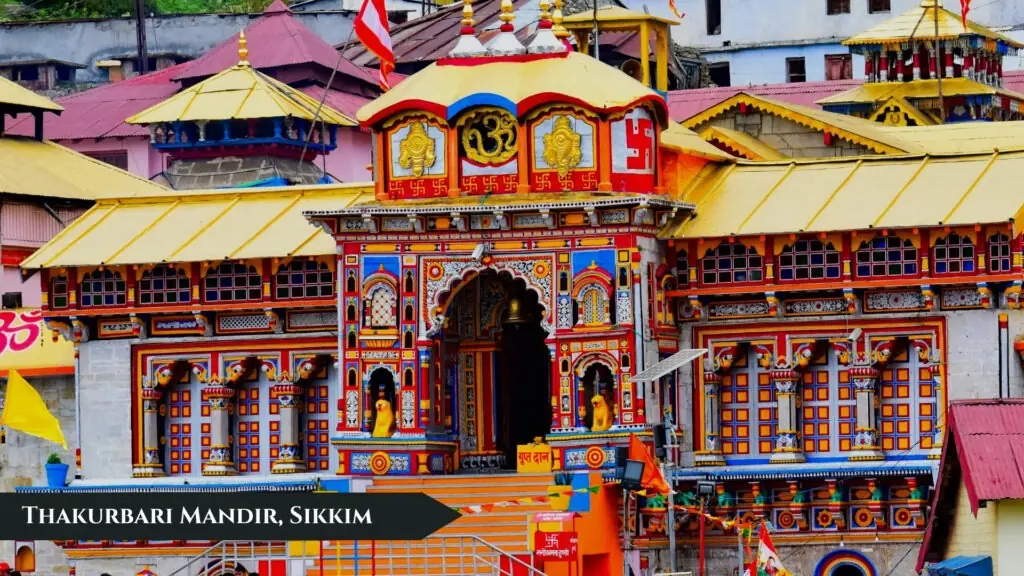
Thakurbari Temple is a prominent Hindu temple in Sikkim dedicated to Lord Krishna. Known for its beautiful architecture and peaceful surroundings, the temple is a place of worship and pilgrimage for devotees from across the state and beyond.
Kirateshwar Temple
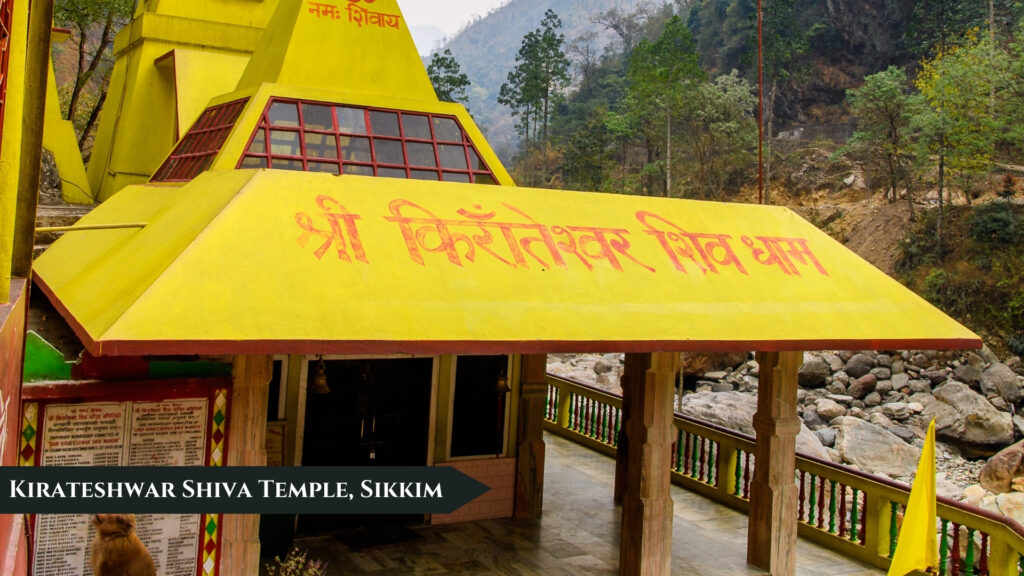
Kirateshwar Temple is dedicated to Lord Shiva and is believed to be the spot where Arjuna, from the Mahabharata, received the divine weapon, Pashupatastra. Surrounded by rich greenery and overlooking the confluence of two rivers, this temple holds great religious significance and attracts devotees seeking blessings and solace.
Vishwa Vinayak Temple
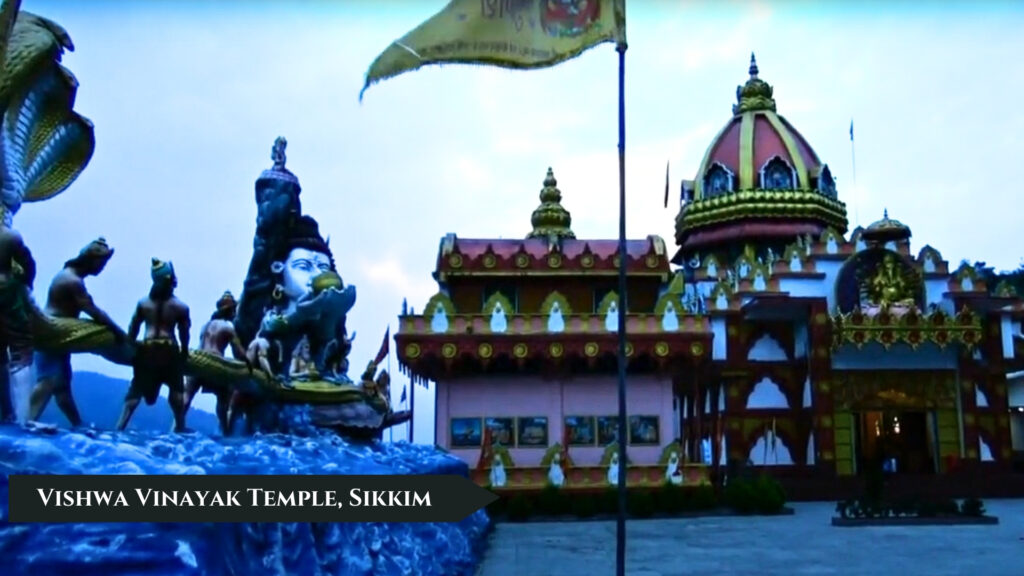
Vishwa Vinayak Temple is a reputed shrine dedicated to Lord Ganesha, the remover of obstacles. Situated in peaceful surroundings, the temple provides devotees with a peaceful space for prayer and reflection, as well as stunning views of the surrounding mountains and valleys.
Samdruptse Temple
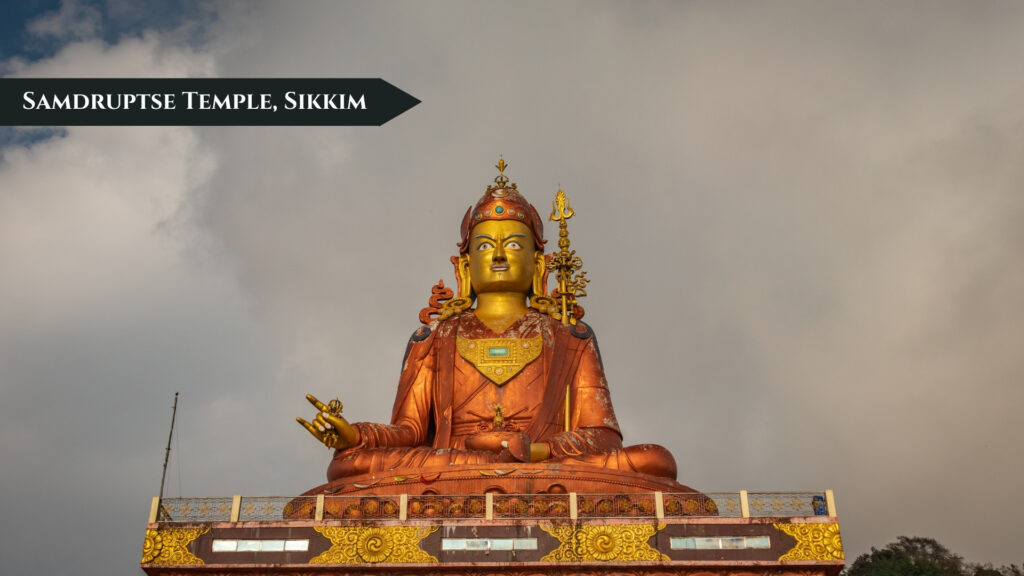
Samdruptse Temple is home to the high statue of Guru Padmasambhava, also known as Guru Rinpoche, who is reputed as the patron saint of Sikkim. Perched on top of a hill, the temple offers panoramic views of the Himalayas and serves as a spiritual beacon for devotees and visitors alike.
Frequently Asked Questions Related To Chardham Temple
Chardham Temple in Pelling, Sikkim, is one of the best temples in Sikkim. You can even catch my journey on my YouTube channel. Here are some of the frequently asked questions about the Chardham Temple in Sikkim:
What is the significance of Chardham Temple?
Char Dham Temple is a significant Hindu shrine that replicates the four sacred Char Dham temples of India, providing a comprehensive spiritual experience.
Where is Chardham Temple located?
The Chardham temple is located in Namchi, South Sikkim, on Solophok Hill.
What is the best time to visit Chardham Temple?
The best time to visit Chardham Temple is during the months of March to June and September to November for clear skies and pleasant weather.
How can one reach Chardham Temple?
The temple can be reached via road from various parts of Sikkim. The nearest airport is Bagdogra in West Bengal, from where you can take a taxi to Namchi and then proceed to the temple.
Is there an entry fee for Chardham Temple?
No, there is no entry fee for visiting the Char Dham Mandir.
What facilities are available for visitors at Chardham Temple?
Basic facilities such as restrooms, drinking water, and a resting area are available. Additionally, nearby shops and eateries provide refreshments and religious offerings.
Are there any special rituals performed at Chardham Temple?
Special pujas and aartis are conducted daily, with grand rituals during major Hindu festivals. Devotees also perform offerings and prayers to seek blessings from various deities.
Is photography allowed inside Chardham Temple?
Photography is generally allowed in the temple premises, but it’s advisable to check with the temple authorities regarding any specific restrictions.
Visiting Char Dham Temple in Sikkim is a unique spiritual journey that offers both devotion and scenic beauty. It’s a place where one can experience the essence of the Char Dham pilgrimage right in the heart of Sikkim. You can refer to the blog on my website on temples in Sikkim to gain more insight and knowledge of these places.

